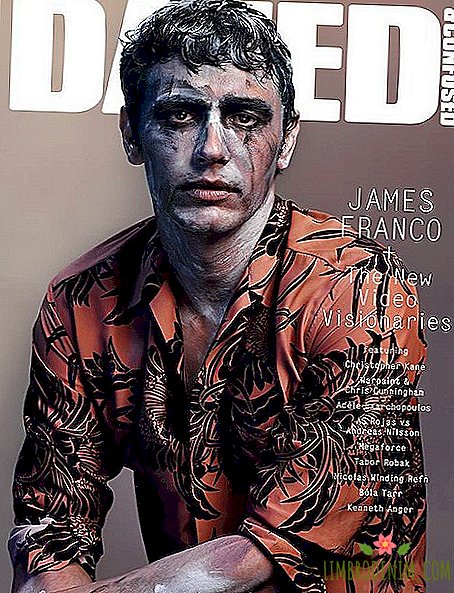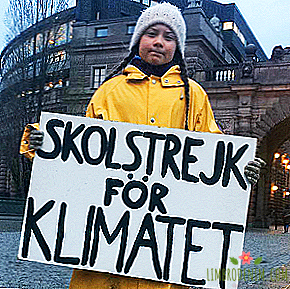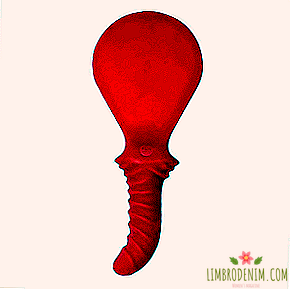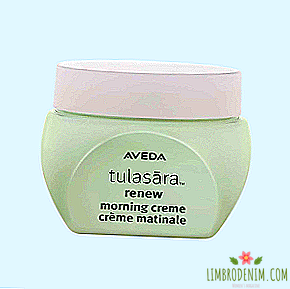From cholo to tumbler: How subcultures set fashion in make-up
Subcultures, like any trends with articulated aesthetics,they always influenced the fashion “from below”, “from the people” - their ideas were picked up by stylists and designers with a tenacious gaze and courageous thinking, and only then turned the fashionable mainstream at shows and in the shootings. No wonder: if subcultural trends are not ahead, they certainly reflect the spirit of the times so clearly that it is impossible to ignore them. There is no need to go far for examples: Vivienne Westwood remains in high fashion as a grandmother of punk, and Rick Owens fans are like followers of a futuristic sect.
The art of make-up, which in recent years has been developing freely and almost unpredictably, also reflected trends that were born in communities very far from the world of the rich and famous. Modern podium make-up artists are not shy to be inspired by trends relevant to very young Internet dwellers, and in general, the influence of social movements extends far more widely than ideas from fashion weeks. Styles of various subcultures affect the understanding and aesthetics of makeup, and today it is noticeably better than ever before.
Tumblr aesthetics, colored hair and glitter
The eternal values on the Internet are not too many, new communities form and dissolve instantly, but their traces often remain in vogue, especially among those over 20 years old. Separate movements develop into entire subcultures, which are marked including in the appearance of the participants. A whole generation of tumblr girls with obligatory multi-colored hair and glitter makeup has grown up before our eyes. The brightest ascent happened in 2010-2013 at Sipank: then the mermaid hair colors and sea themes were mastered by Lady Gaga and Azilia Banks, and in the fashion world these motifs appeared in the collections of Alexander McQueen and Proenza Schouler.
The main trends are changing rapidly, and the birth of the next trend in the global network can provoke anything: Asian fashion, nostalgic aesthetics of the 90s, the emergence of new musical styles and other topical things. In addition, the youth of consumers solves a lot: they are inclined to experiment and collective madness, ready to try and maintain something new and instantly react to the slightest changes around. In general, for manufacturers of cosmetics with a skillful approach, the Internet is a paradise. Decorative cosmetics of non-standard colors are welcome, if it is also packed in an interesting way at the same time - this is a victory: banks and tubes should cause a desire to take pictures with them.
On the one hand, strange and funny experiments are most often suitable only for photos. The same unicorn hair and bubble nails are absolutely beautiful, stupid and not very entertainment frees up, assert a variety of tastes and develop imagination. On the other - a single ideal type of appearance for girls from the Internet still exists. Now this is understandable extreme thinness, baby-face, general infantilism and balancing between the attributes of grunge and what is called cutester. Welcome to Neverland.
K-wave, plastic and pseudo-naturalness
Interest in South Korea first overwhelmed Asia, and then, in the 2000s, and the rest of the world. Korean television and film production, K-pop, and most importantly, the active dissemination of information about the cultural life of the country through the Internet, have borne fruit. Today, it is South Korea that is the leader of cosmetic production, many European brands are not shy about adopting ideas born in Asia: the same Lancôme and Estée Lauder launch new products inspired by Asian examples. The popularity of the original Asian cosmetics in the European and American markets is also somehow not going to fall. The explanations for this phenomenon are quite practical.
In Korea, there is a huge demand for cosmetics among users of both sexes and a fast-growing cosmetic market. The largest brands have a long history in which national traditions of self-care are actively intertwined with European inventions. All production is focused on responding to customer requests, and they are very specific and do not require nudging with fashion. We have already written about the South Korean plastic surgery boom and, in particular, about the fact that in this country there are clearly defined standards in the field of appearance. In the cosmetics industry, this is taken into account, so there can be found less variety in the care systems and goals that pursue the products, but much more attention is paid to the formulas of products and their effectiveness. Peeling, bleaching, restoration, anti-aging care and, importantly, the proper storage of cosmetics - in all of this, Korean manufacturers are unconditional experts.
Due to the high quality standards, the availability of Korean cosmetics and the general interest in the vibrant Asian culture, their trends have assimilated into our territory. The natural radiance of the skin, the understanding of the need for care and the love for products that instantly transform the skin - all this is now also included in European ideas about relationships with appearance.
Drag, Instagram and Redundancy
The image of drag-quin involves tons of cosmetics on the face in the name of grotesque and dramatic femininity, and make-up for them means nothing less than clothes, because they practically paint another face for themselves. Together with the instagram trends oriented to the photoshop effect, drag-aesthetics show redundancy in everything: dense tone, active contouring, a lot of shine and artificiality from nails to eyelashes. In general, everything is used in drag (which is immediately), which in the “ordinary” world is often considered signs of bad taste.
Drag is a rebirth of ideas about an ideal-looking woman with all the standard attributes, but the main difference is that she is deliberately artificial, which means that we have less dangerous seriousness and more sensible irony. In general, the drag could exist quietly and in isolation from the general public: the tradition of entertaining the public by reincarnating artists into members of the opposite sex, it must be admitted, is too old. The most popular drag show of our time "Ru Paul's Drag Race" has been going on since 2009, but last year the contribution of its participants to the beauty industry has become much more noticeable. This was facilitated by discussions around the position of the LGBT community, and an honest talk about make-up shaming that Nikki de Jager, girlfriend Jeffrey Star, and a well-known lover of the shooter half-face and generously sprinkled on the cheekbones with a highlight on her channel, started her channel. Her video "The Power of Makeup" was watched by thirty million people.
The idea of the drag-make-up itself is opposed to the “natural” make-up in Europe, which is desperately disguised as it is completely absent - it is not known what is a big deception. This is the direct opposite of the idea of "improving": for drag makeup is becoming a way to relax, dream up and play, they claim its magic power. The fashion for freedom to be whoever you want, whatever basic set you had by nature - but less aggressive and radical than the one that remained to us after the 2000s - with a rigid framework of ideas about the “perfect” appearance and other fear of cellulite and aging. Typical "female" instastandards sin with the same unrealism, but most of them advocate transformation using make-up, rather than using radical methods like plastic surgeries.
Another result of the increased interest in drag aesthetics is that beauty queens are now happy to give advice from the field of their professional life. With all the desire, we cannot recommend such cruel methods as fixing makeup with hairspray, but in drag-quin instagrams there are many more interesting and applicable in everyday life.
Cholo, hip-hop and aggressive sexuality
Another couple of examples of style, mixed with national identity, with its own history and traditions. Both cholo and hip-hop are subcultures of ethnic minorities, both about the working class and gangsta-life. They developed hand in hand in the 90s and in the accepted interpretations of the status of women in society are also very similar, and hence the regulation of a certain appearance. Chola girls and hip-hop divas are characterized by challenging sexuality, but in their native cultures typical European “women in trouble” and Cinderella are unpopular. Women openly fight for their own place. They work, do music, do what they see fit, and are capable of independence. All their decorations are a demonstration of strength and independence.
Cholas style, of course, is repelled by the bright appearance of Latin Americans, who are trying to make it even brighter: a classic make-up will be a combination of "cat's eyes" and a dark lip contour. Interpretations in the make-up of celebrities can be found as many as you like. Gwen Stefani, Rihanna, FKA twigs add elements to the make-up that hint at the cholo style: dark lipsticks, loose eyes and lush hair, loose or tied with a bandana. Fashion houses were also inspired by the assertive beauty of cholas: motifs were present in makeup for Rodarte and Givenchy shows.
In hip-hop women have many roles: you can be a performer, hip-hop model, the wife of a cool guy, and you can combine. Appearances are also a million: from elegant Beyoncé to reckless Amber Rose. The main signs in any case - it is a luxury and brightness. A lot of gold, a lot of wigs and hairstyles that can be changed at least every day, rich colors, shading skin. The images, in general, correlate with the European fashion of the 1990s and 2000s. Traditionally, in the texts and clips of rap artists, women are objectified to the limit, but now women in hip-hop actively try to defend the right to sexuality for themselves, raise feminist questions and sharply answer men.
Another important cultural amendment that was presented to us by hip-hop divas is a completely different type of figure. The representatives of this community esteem pomp. While European fashion puts on non-standard volumes marking "plus-size" and assigns them a separate place, it is hip-hop stars that show the most effective results in supporting and glorifying sisters wearing jeans larger than the 25th size.
Health Goths and Futurism
Gothic as a whole is experiencing a new round of relevance and has appeared in various guises and in street fashion, and haute couture, and in the darkest corners of the Internet. Health is an attempt to look into the future and to generate more fresh futuristic tendencies. The meaning of clothes is in its convenience: the obligatory black color, high-tech fabrics, sports styles - most likely, you already know all this and are hardly forgotten.
There is no distinctive makeup for health-ready, since the rules are simple and logically proceed from the general style: its adherents choose minimalism, dark colors and clear lines. But the fact is that the futuristic makeup trends are still marked, especially after the release of Mad Max, for which makeup artist Leslie Vanderwalt has done her best. The film inspired many bloggers and makeup artists to create postapocalyptic images. Although fantasies about the people of the future with frighteningly painted faces and coarse, sun-burned skin are, of course, a picture of a not quite bright future.
The futuristic line continues, first of all, a surge of interest in metallic shades and textures. This year, reflections on a given topic were also shown on the catwalk: Rihanna’s models on the Fenty x Puma show were excited by thick white hair and black lips, and Opening Ceremony showed cyborgs created with ubiquitous glitter. A lot of interesting images appeared on Met Gala - 2016; We are waiting for all this to develop for the new season.





